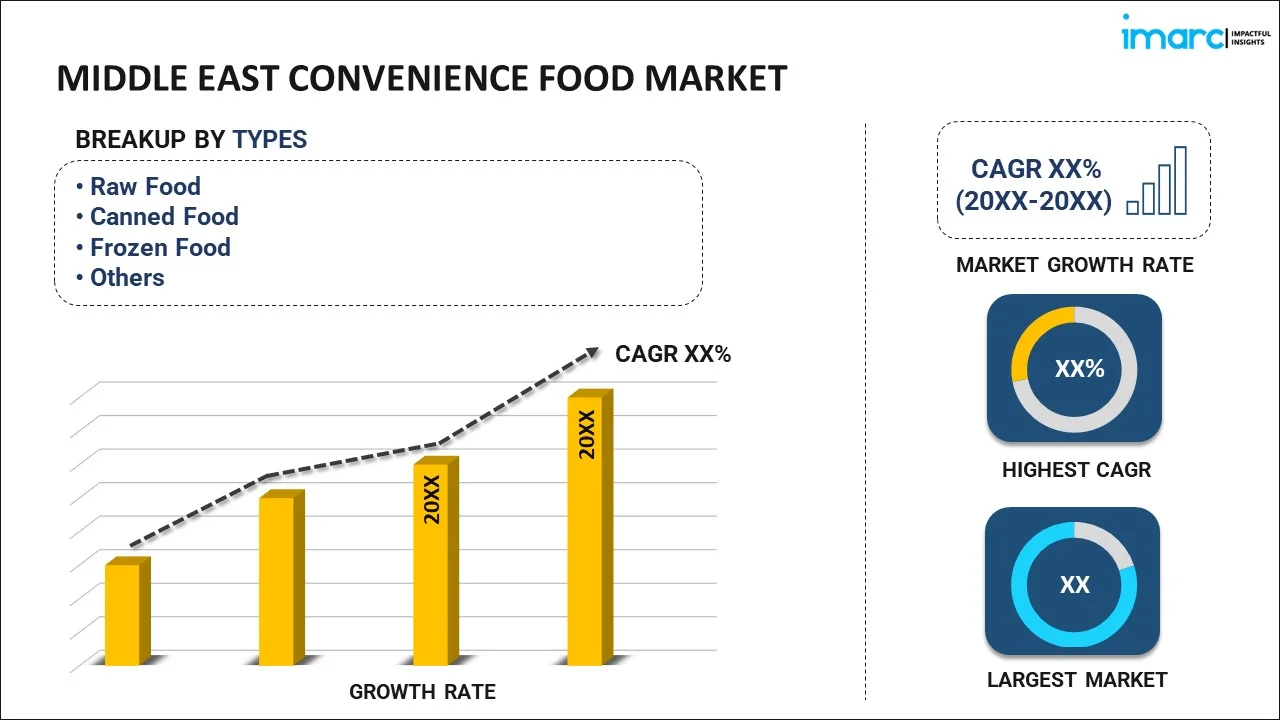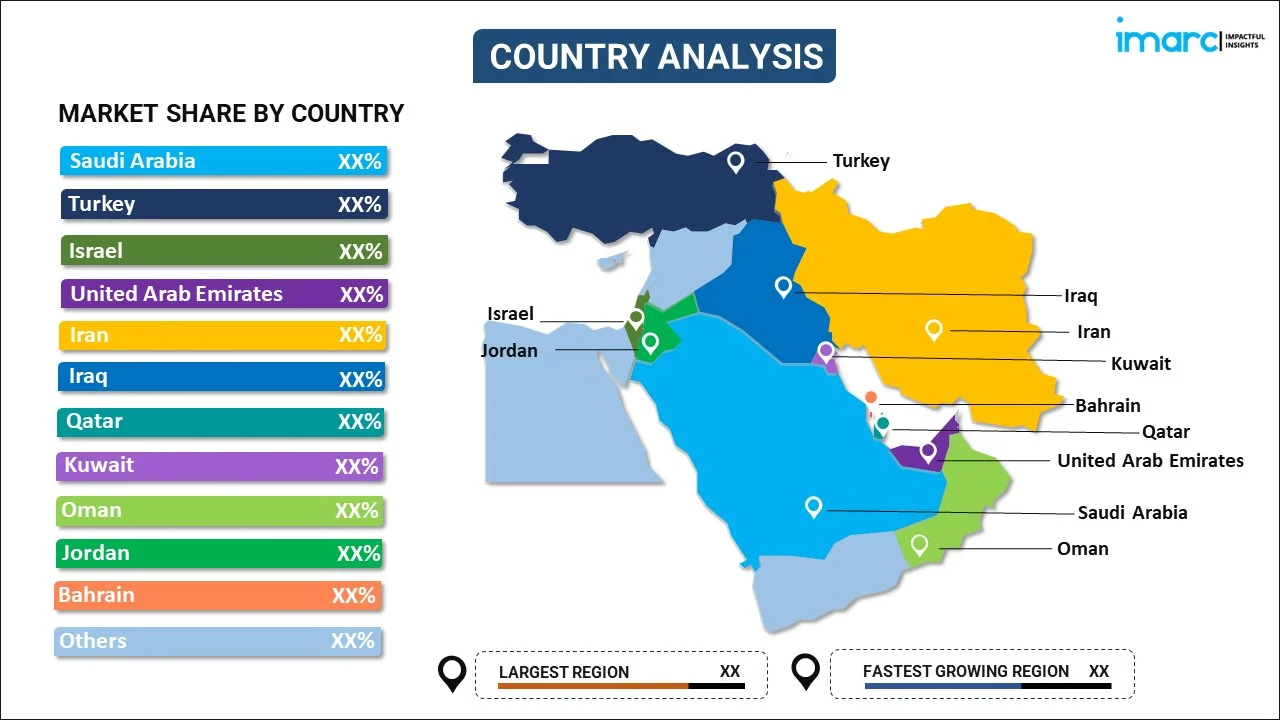
Middle East Convenience Food Market Report by Type (Raw Food, Canned Food, Frozen Food, Ready-To-Eat, Ready-To-Cook, and Others), Product (Meat/Poultry Products, Cereal-based Products, Vegetable-based Products, and Others), Distribution Channel (Supermarkets and Hypermarkets, Convenience Stores, Specialty Stores, and Others), and Country 2025-2033
Market Overview:
Middle East convenience food market size reached USD 22,611 Million in 2024. Looking forward, IMARC Group expects the market to reach USD 32,004 Million by 2033, exhibiting a growth rate (CAGR) of 3.94% during 2025-2033. The growing demand for ready-to-eat (RTE) and ready-to-cook (RTC) food products, due to the busy lifestyle of consumers and changing eating habits, is primarily driving the regional market.
|
Report Attribute
|
Key Statistics
|
|---|---|
|
Base Year
|
2024
|
|
Forecast Years
|
2025-2033
|
|
Historical Years
|
2019-2024
|
|
Market Size in 2024
|
USD 22,611 Million |
|
Market Forecast in 2033
|
USD 32,004 Million |
| Market Growth Rate 2025-2033 | 3.94% |
Convenience food encompasses items that undergo processing, preparation, or packaging to facilitate swift and straightforward consumption. These products offer a convenient and time-saving option for consumers, allowing them to prepare and savor a meal without the need for extensive cooking or planning. Typically, convenience foods are either pre-cooked or pre-packaged, ensuring increased ease, prolonged shelf life, and uncomplicated storage. Marketed in diverse forms, including frozen meals, canned goods, instant noodles, snacks, and fast food, these products cater to varying tastes and preferences. It's noteworthy that convenience foods often exhibit elevated levels of calories, fat, and sodium, potentially lacking essential nutrients such as fiber and vitamins. The popularity of convenience foods stems from the demands of modern, fast-paced lifestyles, where individuals seek quick and efficient meal solutions to accommodate their hectic schedules.
Middle East Convenience Food Market Trends:
The Middle East convenience food market stands as a reflection of the region's evolving lifestyle and changing dietary habits. This market, characterized by a diverse array of processed and readily prepared food items, has gained prominence as an integral part of the culinary landscape in the country. Besides this, offering quick and hassle-free meal solutions, convenience foods cater to the demands of individuals with busy schedules, providing a convenient alternative to traditional cooking, which is positively influencing the regional market. Moreover, the Middle East convenience food market includes a wide range of products, from frozen meals and canned goods to instant noodles and fast food options, thereby acting as another significant growth-inducing factor. Emphasizing convenience, these products are often pre-cooked or pre-packaged, ensuring not only ease of preparation but also extended shelf stability. Nevertheless, the convenience food market in the Middle East will continue to thrive, reflecting the region's dynamic socio-cultural shifts and the growing importance of convenience in dietary choices, over the forecasted period.
Middle East Convenience Food Market Segmentation:
IMARC Group provides an analysis of the key trends in each segment of the market, along with forecasts at the regional and country levels for 2025-2033. Our report has categorized the market based on type, product, and distribution channel.
Type Insights:

- Raw Food
- Canned Food
- Frozen Food
- Ready-To-Eat
- Ready-To-Cook
- Others
The report has provided a detailed breakup and analysis of the market based on the type. This includes raw food, canned food, frozen food, ready-to-eat, ready-to-cook, and others.
Product Insights:
- Meat/Poultry Products
- Cereal-based Products
- Vegetable-based Products
- Others
A detailed breakup and analysis of the market based on the product have also been provided in the report. This includes meat/poultry products, cereal-based products, vegetable-based products, and others.
Distribution Channel Insights:
- Supermarkets and Hypermarkets
- Convenience Stores
- Specialty Stores
- Others
The report has provided a detailed breakup and analysis of the market based on the distribution channel. This includes supermarkets and hypermarkets, convenience stores, specialty stores, and others.
Country Insights:

- Saudi Arabia
- Turkey
- Israel
- United Arab Emirates
- Iran
- Iraq
- Qatar
- Kuwait
- Oman
- Jordan
- Bahrain
- Others
The report has also provided a comprehensive analysis of all the major regional markets, which include Saudi Arabia, Turkey, Israel, United Arab Emirates, Iran, Iraq, Qatar, Kuwait, Oman, Jordan, Bahrain, and Others.
Competitive Landscape:
The market research report has also provided a comprehensive analysis of the competitive landscape in the market. Competitive analysis such as market structure, key player positioning, top winning strategies, competitive dashboard, and company evaluation quadrant has been covered in the report. Also, detailed profiles of all major companies have been provided.
Middle East Convenience Food Market Report Coverage:
| Report Features | Details |
|---|---|
| Base Year of the Analysis | 2024 |
| Historical Period | 2019-2024 |
| Forecast Period | 2025-2033 |
| Units | Million USD |
| Scope of the Report | Exploration of Historical and Forecast Trends, Industry Catalysts and Challenges, Segment-Wise Historical and Predictive Market Assessment:
|
| Types Covered | Raw Food, Canned Food, Frozen Food, Ready-To-Eat, Ready-To-Cook, Others |
| Products Covered | Meat/Poultry Products, Cereal-based Products, Vegetable-based Products, Others |
| Distribution Channels Covered | Supermarkets and Hypermarkets, Convenience Stores, Specialty Stores, Others |
| Countries Covered | Saudi Arabia, Turkey, Israel, United Arab Emirates, Iran, Iraq, Qatar, Kuwait, Oman, Jordan, Bahrain, Others |
| Customization Scope | 10% Free Customization |
| Post-Sale Analyst Support | 10-12 Weeks |
| Delivery Format | PDF and Excel through Email (We can also provide the editable version of the report in PPT/Word format on special request) |
Key Questions Answered in This Report:
- How has the Middle East convenience food market performed so far and how will it perform in the coming years?
- What has been the impact of COVID-19 on the Middle East convenience food market?
- What is the breakup of the Middle East convenience food market on the basis of type?
- What is the breakup of the Middle East convenience food market on the basis of product?
- What is the breakup of the Middle East convenience food market on the basis of distribution channel?
- What are the various stages in the value chain of the Middle East convenience food market?
- What are the key driving factors and challenges in the Middle East convenience food?
- What is the structure of the Middle East convenience food market and who are the key players?
- What is the degree of competition in the Middle East convenience Food market?
Key Benefits for Stakeholders:
- IMARC’s industry report offers a comprehensive quantitative analysis of various market segments, historical and current market trends, market forecasts, and dynamics of the Middle East convenience food market from 2019-2033.
- The research report provides the latest information on the market drivers, challenges, and opportunities in the Middle East convenience food market.
- Porter's five forces analysis assist stakeholders in assessing the impact of new entrants, competitive rivalry, supplier power, buyer power, and the threat of substitution. It helps stakeholders to analyze the level of competition within the Middle East convenience food industry and its attractiveness.
- Competitive landscape allows stakeholders to understand their competitive environment and provides an insight into the current positions of key players in the market.
Need more help?
- Speak to our experienced analysts for insights on the current market scenarios.
- Include additional segments and countries to customize the report as per your requirement.
- Gain an unparalleled competitive advantage in your domain by understanding how to utilize the report and positively impacting your operations and revenue.
- For further assistance, please connect with our analysts.
 Request Customization
Request Customization
 Speak to an Analyst
Speak to an Analyst
 Request Brochure
Request Brochure
 Inquire Before Buying
Inquire Before Buying




.webp)




.webp)












